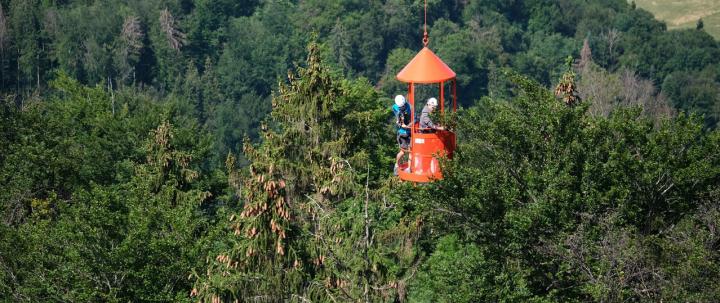
Credit: Manuela Schwendener / University of Basel
The extreme summer drought of 2018 was a special situation for both nature and scientists. It was very hard on the forest. At the same time, it offered researchers from the Universities of Basel (Switzerland) and Würzburg (Germany) the opportunity to study the reaction of trees to this climatic phenomenon.
Research in the treetops
“The summer of 2018 was hotter and drier than in any other year since weather records began,” says ecophysiologist Professor Bernhard Schuldt from the University of Wuerzburg. Together with Dr Matthias Arend and Professor Ansgar Kahmen from the University of Basel, he was significantly involved in the study, which is published in the scientific journal PNAS. “A unique opportunity arose for us to study the influence of extreme heat and drought on large and old trees.”
Using a crane set up in the forest, the researchers examined ten randomly selected spruce trees near Basel. They were all over 100 years old and around 30 metres high. The seasonal fluctuations of the water balance were measured directly in the uppermost tree crown.
Low but continuous water loss
The researchers are particularly interested in the duration and intensity of the drought that causes the water-conducting system in the wood to collapse. Due to its shallow root system, spruce in particular is susceptible to drought stress.
“We were able to show that the trees eventually die because their water-conducting system collapses within a very short time after a long drought,” says Professor Schuldt. This, he says, is due to the small but continuous loss of water that takes place via the surfaces of the needles despite the fact that the leaf pores are closed.
The realisation that trees in general, and spruce in particular, suffer from drought is not news. For research, however, it is important to understand the processes underlying tree death in detail. This is exactly what the scientists from Basel and Wuerzburg have achieved with the study. “Our results provide an important contribution to improve predictions of drought-induced tree mortality,” explains Schuldt.
Death comes very suddenly
The new results prove how dangerous heat waves are for trees due to the high dryness of the atmosphere and the associated high evaporation. According to the findings, the trees’ hydraulic system can collapse completely within a very short time during the drought. Until now, it was assumed that this happens gradually as soon as the water supply from the soil is interrupted and the internal water reservoir are empty.
The decisive factor here is that the dehydration of the plant tissue does not seem to be a continuous process, but rather takes place abruptly after a species-specific threshold value has been exceeded. The spruce trees were unable to recover from this. “Whether this applies to other tree species such as beech, which was also severely affected by the drought, still needs to be clarified,” says Schuldt.
###
Media Contact
Prof. Dr. Bernhard Schuldt
[email protected]
Original Source
https:/
Related Journal Article
http://dx.




